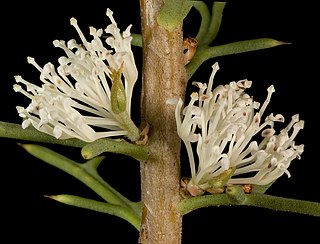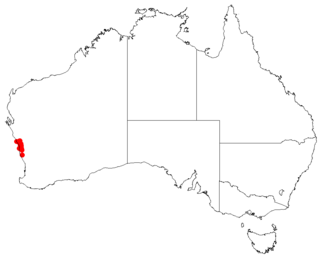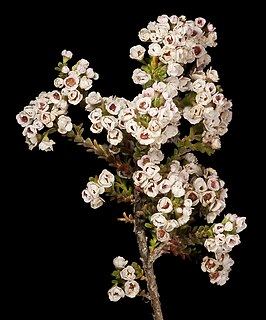
Hakea petiolaris, commonly known as the sea-urchin hakea, is a shrub or small tree with cream-coloured and pink or purple flowers and woody fruit. It is endemic to the south west of Australia, occurring at the coastal plain, jarrah forest and wheatbelt regions, often at the ancient granite outcrops of Western Australia.

Persoonia coriacea, commonly known as the leathery-leaf persoonia, is a species of flowering plant in the family Proteaceae and is endemic to the south-west of Western Australia. It is an erect to spreading shrub with smooth bark, spatula-shaped or elliptic to linear leaves and bright yellow flowers borne in groups of up to ten along a rachis up to 70 mm (2.8 in) long.
Persoonia bowgada is a species of flowering plant in the family Proteaceae and is endemic to the south-west of Western Australia. It is an erect to spreading shrub with smooth bark, more or less cylindrical leaves and yellow flowers in groups of up to ten on the ends of branches.

Hakea circumalata is a shrub in the family Proteaceae native to an area in the Wheatbelt and Mid West regions of Western Australia. A small shrub producing a profusion of strongly scented pink to red flowers in dense clusters from July to September.

Hakea falcata, commonly known as sickle hakea, is a shrub in the family Proteacea and is endemic to southern Western Australia. It has narrow egg-shaped leaves, cream flowers and blooms in spring.

Hakea invaginata is a shrub in the family Proteacea and is endemic to Western Australia. It has purplish-pink flowers, smooth needle-shaped leaves and the branchlets are thickly covered in hairs.

Hakea varia, commonly known as the variable-leaved hakea, is a shrub of the family Proteacea and endemic to Wheatbelt, South West, Great Southern and Goldfields-Esperance regions of Western Australia. It is a dense prickly shrub with creamy-white or yellow flowers and variable shaped leaves.

Hakea polyanthema is a species of flowering plant in the family Proteacea an is endemic to Western Australia. It is a shrub with needle-shaped leaves and small groups of small unpleasantly scented flowers in leaf axils.
Scholtzia capitata is a shrub species in the family Myrtaceae that is endemic to Western Australia.
Scholtzia ciliata is a shrub species in the family Myrtaceae that is endemic to Western Australia.
Scholtzia drummondii is a shrub species in the family Myrtaceae that is endemic to Western Australia.
Scholtzia eatoniana is a shrub species in the family Myrtaceae that is endemic to Western Australia.

Scholtzia involucrata, commonly known as spiked scholtzia, is a shrub species in the family Myrtaceae that is endemic to Western Australia.
Scholtzia leptantha is a shrub species in the family Myrtaceae that is endemic to Western Australia.

Scholtzia parviflora is a shrub species in the family Myrtaceae that is endemic to Western Australia.
Scholtzia spatulata is a shrub species in the family Myrtaceae that is endemic to Western Australia.
Scholtzia teretifolia is a shrub species in the family Myrtaceae that is endemic to Western Australia.
Scholtzia umbellifera is a shrub species in the family Myrtaceae that is endemic to Western Australia.
Thryptomene decussata is a species of flowering plant in the family Myrtaceae and is endemic to Western Australia. It is an erect shrub with upward pointing, egg-shaped leaves, and white or pink flowers with five petals and twenty to thirty stamens in two whorls.

Thryptomene denticulata is a shrub species in the family Myrtaceae that is endemic to Western Australia.









